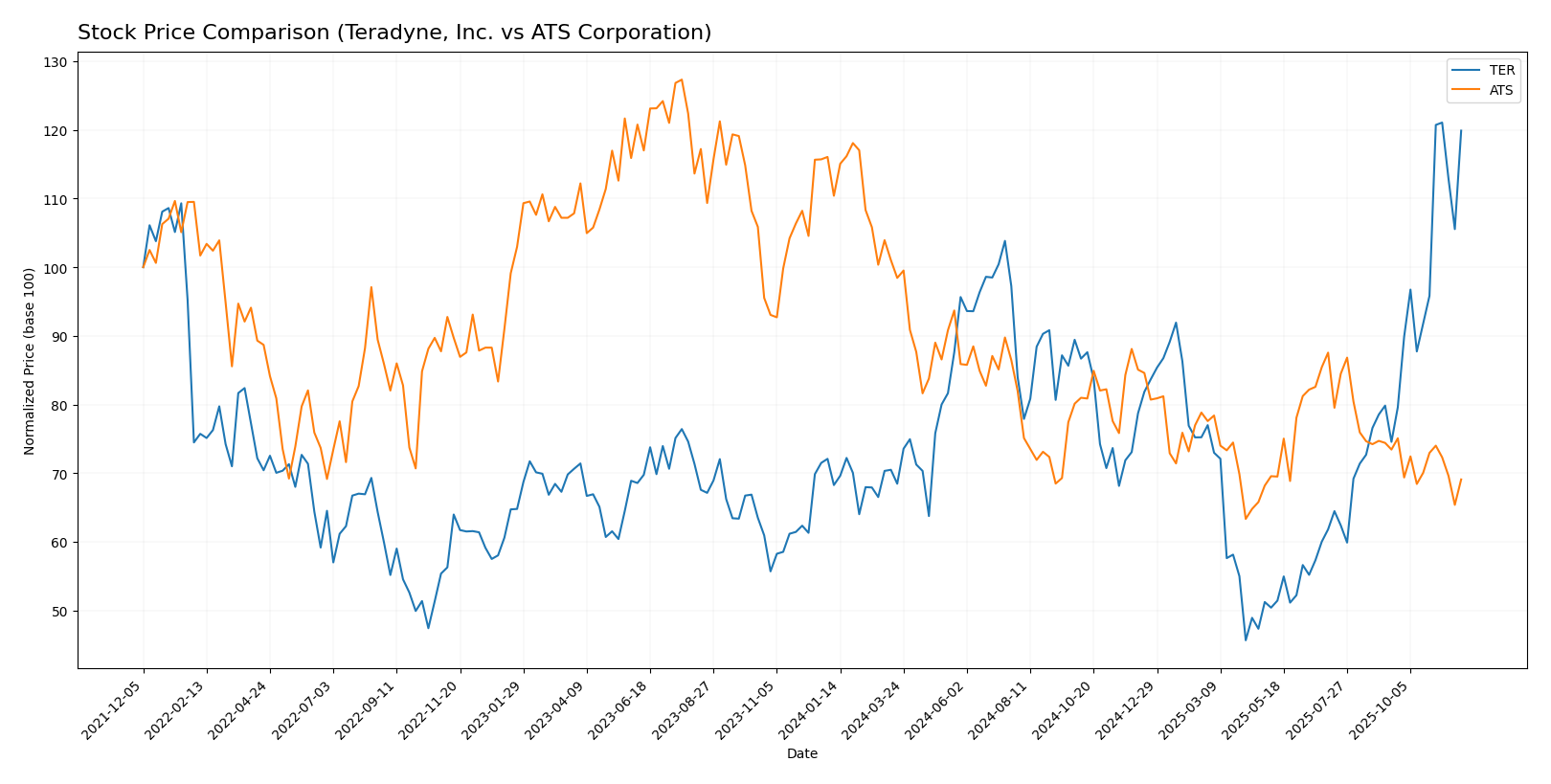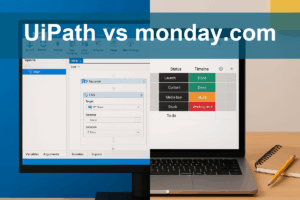In today’s rapidly evolving market, understanding the nuances between companies is crucial for informed investment decisions. This article compares Teradyne, Inc. (TER) and ATS Corporation (ATS), two key players in automation and testing solutions. While Teradyne specializes in semiconductor testing, ATS focuses on broader industrial automation. Both firms are poised for growth, but their innovation strategies and market overlaps present unique opportunities. Join me as we explore which company stands out as the more compelling investment choice.

Table of contents
Company Overview
Teradyne, Inc. Overview
Teradyne, Inc. (Ticker: TER) is a leading provider of automatic test equipment, primarily serving the semiconductor industry. Founded in 1960 and headquartered in North Reading, Massachusetts, Teradyne designs and manufactures testing solutions for a diverse array of applications, including automotive, industrial, and consumer electronics. The company operates through four main segments: Semiconductor Test, System Test, Industrial Automation, and Wireless Test. This broad portfolio allows Teradyne to cater to both integrated device manufacturers and fabless companies, ensuring high testing efficiency across various technologies. With a market capitalization of approximately $29.2B, Teradyne is well-positioned in the technology sector, focusing on innovation to meet the growing demands of the semiconductor market.
ATS Corporation Overview
ATS Corporation (Ticker: ATS) specializes in automation solutions, primarily focusing on the design and implementation of automated manufacturing and assembly systems. Founded in 1978 and headquartered in Cambridge, Canada, ATS provides a comprehensive range of automation products and services, including pre- and post-automation consulting, training, process optimization, and equipment relocation. The company serves a wide variety of industries, such as life sciences, food and beverage, and consumer products. With a market capitalization of about $2.5B, ATS is recognized for its capability to enhance operational efficiency and deliver sustainable production improvements through innovative automation solutions.
Key similarities and differences
Both Teradyne and ATS are leaders in their respective fields, emphasizing automation and testing solutions. However, Teradyne primarily targets the semiconductor industry, while ATS offers broader automation solutions across various sectors. This distinction highlights Teradyne’s specialized focus compared to ATS’s diverse service offerings in industrial automation.
Income Statement Comparison
The following table provides a comparison of the most recent income statements for Teradyne, Inc. and ATS Corporation. This data can help investors gauge the financial health and performance trends of these companies.
| Metric | Teradyne, Inc. | ATS Corporation |
|---|---|---|
| Market Cap | 29.22B | 2.50B |
| Revenue | 2.82B | 2.53B |
| EBITDA | 732M | 168M |
| EBIT | 613M | 15M |
| Net Income | 542M | -28M |
| EPS | 3.41 | -0.29 |
| Fiscal Year | 2024 | 2025 |
Interpretation of Income Statement
In the most recent fiscal year, Teradyne demonstrated solid revenue growth, increasing from 2.67B in 2023 to 2.82B in 2024, while maintaining a healthy net income of 542M. In contrast, ATS experienced declining revenue from 3.03B in 2024 to 2.53B in 2025, leading to a net loss of 28M. Teradyne’s EBITDA margin improved, reflecting effective cost management, whereas ATS showed a significant drop in profitability, indicating potential challenges that may require strategic adjustments. Overall, Teradyne appears to be in a stronger financial position compared to ATS.
Financial Ratios Comparison
The following table presents a comparative analysis of key financial metrics for Teradyne, Inc. (TER) and ATS Corporation (ATS) based on the most recent fiscal year data.
| Metric | Teradyne, Inc. (TER) | ATS Corporation (ATS) |
|---|---|---|
| ROE | 19.24% | -1.64% |
| ROIC | 17.25% | 0.09% |
| P/E | 36.93 | -125.28 |
| P/B | 7.11 | 2.06 |
| Current Ratio | 2.91 | 1.69 |
| Quick Ratio | 1.84 | 1.41 |
| D/E | 0.03 | 1.00 |
| Debt-to-Assets | 2.07% | 36.79% |
| Interest Coverage | 165.54 | 0.09 |
| Asset Turnover | 0.76 | 0.55 |
| Fixed Asset Turnover | 4.88 | 5.66 |
| Payout ratio | 14.09% | 0% |
| Dividend yield | 0.38% | 0% |
Interpretation of Financial Ratios
Teradyne demonstrates strong profitability and liquidity with a robust ROE of 19.24% and a current ratio of 2.91, indicating good financial health. In contrast, ATS shows concerning metrics, such as a negative ROE and high debt levels, reflected in its D/E ratio of 1.00 and an interest coverage ratio of only 0.09. These figures suggest ATS may face significant financial challenges, making it a riskier investment compared to Teradyne.
Dividend and Shareholder Returns
Teradyne, Inc. (TER) pays a dividend of $0.48 per share, with a payout ratio of approximately 14%. The consistent dividend payments and a modest annual yield of 0.38% indicate a commitment to shareholder returns, although the low yield suggests limited immediate income potential. Teradyne also engages in share buybacks, enhancing value for shareholders.
In contrast, ATS Corporation (ATS) does not distribute dividends, reflecting its focus on reinvestment for growth, particularly during its current recovery phase. However, ATS is actively repurchasing shares, which could signal confidence in future profitability. Overall, Teradyne’s dividend strategy supports sustainable shareholder value, while ATS’s approach may align with long-term growth objectives.
Strategic Positioning
In the semiconductor and automation sectors, Teradyne, Inc. (TER) commands a significant market share, primarily through its robust Semiconductor Test segment, which addresses diverse applications such as automotive and industrial testing. Its competitive edge is bolstered by advanced technologies and a comprehensive product portfolio. Conversely, ATS Corporation (ATS) operates in a more fragmented industrial automation market, facing competitive pressure from both established and emerging players. Both companies must navigate technological disruptions to maintain their market positions and capitalize on growth opportunities.
Stock Comparison
Over the past year, Teradyne, Inc. (TER) and ATS Corporation (ATS) have experienced significant price movements, showcasing contrasting trading dynamics. While TER has demonstrated remarkable growth, ATS has faced notable declines.

Trend Analysis
Teradyne, Inc. (TER)
Analyzing the stock trend over the past year, TER shows a percentage change of +76.99%. This substantial increase indicates a bullish trend, supported by acceleration in its price movement. The stock reached a notable high of $182.28 and a low of $68.72, reflecting a standard deviation of 24.53, which indicates a relatively high volatility. Recently, from September 14, 2025, to November 30, 2025, the stock had a price change of +62.05%, maintaining an upward slope with a trend slope of 5.94.
ATS Corporation (ATS)
In contrast, ATS has experienced a percentage change of -37.73% over the past year, indicating a bearish trend with signs of deceleration. The stock has fluctuated between a high of $43.82 and a low of $23.50, with a standard deviation of 4.45, suggesting lower volatility compared to TER. The recent trend from September 14, 2025, to November 30, 2025, shows a decline of -6.39%, with a trend slope of -0.15, further affirming the downward trajectory.
In summary, while TER is on a bullish path with strong momentum, ATS is struggling in a bearish trend, reflecting the divergent fortunes of these two companies in the current market environment.
Analyst Opinions
Recent recommendations for Teradyne, Inc. (TER) indicate a “Buy” rating, based on strong return on assets (score 5) and overall solid financial health (overall score 3). Analysts suggest its growth potential justifies the investment, despite a lower score in price-to-earnings (1). In contrast, ATS Corporation (ATS) holds a “Hold” rating, with a weaker overall score of 2. Analysts cite concerns regarding its return on equity (1) and debt-to-equity ratio (1) as reasons for caution. The consensus for Teradyne is a “Buy,” while ATS leans toward “Hold.”
Stock Grades
I have gathered the latest stock grades from recognized grading companies for two companies: Teradyne, Inc. and ATS Corporation. Here’s a detailed overview of their current ratings.
Teradyne, Inc. Grades
| Grading Company | Action | New Grade | Date |
|---|---|---|---|
| Citigroup | maintain | Buy | 2025-11-12 |
| JP Morgan | maintain | Neutral | 2025-10-30 |
| Goldman Sachs | maintain | Sell | 2025-10-30 |
| Evercore ISI Group | maintain | Outperform | 2025-10-30 |
| UBS | maintain | Buy | 2025-10-30 |
| Stifel | maintain | Hold | 2025-10-28 |
| Evercore ISI Group | maintain | Outperform | 2025-10-28 |
| UBS | maintain | Buy | 2025-10-20 |
| Morgan Stanley | maintain | Equal Weight | 2025-10-14 |
| Stifel | maintain | Hold | 2025-10-13 |
ATS Corporation Grades
| Grading Company | Action | New Grade | Date |
|---|---|---|---|
| JP Morgan | maintain | Neutral | 2024-08-13 |
| Goldman Sachs | maintain | Sell | 2024-08-13 |
| JP Morgan | maintain | Neutral | 2024-05-24 |
Overall, Teradyne, Inc. has a mix of grades, with both “Buy” and “Sell” ratings reflecting a diverse outlook among analysts. Meanwhile, ATS Corporation appears to be viewed more cautiously, with its grades remaining neutral and selling pressure indicated. This suggests a more stable but less bullish sentiment for ATS.
Target Prices
The current analyst consensus for Teradyne, Inc. and ATS Corporation provides insights into their expected price movements.
| Company | Target High | Target Low | Consensus |
|---|---|---|---|
| Teradyne, Inc. | 215 | 119 | 172.67 |
| ATS Corporation | 34 | 34 | 34 |
For Teradyne, the target consensus of 172.67 suggests a potential upside given its current price of 181.9. In contrast, ATS Corporation’s target consensus matches its current price of 25.51, indicating a more stable outlook.
Strengths and Weaknesses
The following table summarizes the strengths and weaknesses of Teradyne, Inc. (TER) and ATS Corporation (ATS) based on recent data.
| Criterion | Teradyne, Inc. | ATS Corporation |
|---|---|---|
| Diversification | High | Moderate |
| Profitability | Strong (19.2%) | Weak (-1.1%) |
| Innovation | Leading | Moderate |
| Global presence | Extensive | Limited |
| Market Share | Significant | Small |
| Debt level | Low (2.1%) | High (36.8%) |
Key takeaways indicate that Teradyne boasts strong profitability and low debt, making it an attractive option for risk-averse investors. In contrast, ATS faces profitability challenges and higher debt levels, which may raise concerns for potential investors.
Risk Analysis
The following table outlines key risks associated with each company to provide a clearer understanding of potential challenges.
| Metric | Teradyne, Inc. | ATS Corporation |
|---|---|---|
| Market Risk | Moderate | High |
| Regulatory Risk | Low | Moderate |
| Operational Risk | Moderate | High |
| Environmental Risk | Low | Moderate |
| Geopolitical Risk | Low | High |
In summary, Teradyne, Inc. faces moderate operational risks and low market risks, while ATS Corporation experiences higher operational and market risks. Recent market volatility and regulatory changes could significantly impact ATS’s performance.
Which one to choose?
When comparing Teradyne, Inc. (TER) and ATS Corporation (ATS), Teradyne appears to be the more robust option for investors. TER has a higher gross profit margin of 58.5%, a strong net profit margin of 19.2%, and a solid return on equity of 19.2%. Analysts rate TER with a “B,” reflecting its favorable fundamentals and bullish stock trend, highlighted by a 76.99% price increase over the past year. Conversely, ATS has struggled with a bearish trend, showing a 37.73% decline and a “C” rating, indicating weaker performance metrics, including a negative net income.
For growth-oriented investors, I recommend Teradyne due to its strong financial health and growth potential. Those seeking stability might find ATS appealing despite its challenges, but caution is warranted due to its recent performance.
Specific risks for both companies include market dependence and competitive pressures in their respective sectors.
Disclaimer: This article is not financial advice. Each investor is responsible for their own investment decisions.
Go further
I encourage you to read the complete analyses of Teradyne, Inc. and ATS Corporation to enhance your investment decisions:



